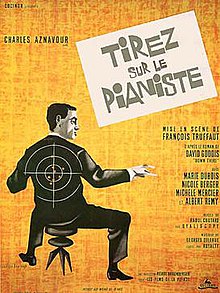Shoot the Piano Player
| Shoot the Piano Player | |
|---|---|

Theatrical release poster
|
|
| Directed by | François Truffaut |
| Produced by | Pierre Braunberger |
| Screenplay by |
|
| Based on |
Down There by David Goodis |
| Starring | |
| Music by | Georges Delerue |
| Cinematography | Raoul Coutard |
| Edited by |
|
|
Production
company |
Les Films de la Pléiade
|
| Distributed by | Les Films du Carrosse |
|
Release date
|
|
|
Running time
|
81 minutes |
| Country | France |
| Language | French |
| Budget | ₣890,062.95 |
| Box office | 974,833 admissions (France) |
Shoot the Piano Player (French: Tirez sur le pianiste; UK title: Shoot the Pianist) is a 1960 French crime drama film directed by François Truffaut and starring Charles Aznavour as the titular pianist. It is based on the novel Down There by David Goodis.
A washed-up classical pianist, Charlie Kohler/Edouard Saroyan (Charles Aznavour), bottoms out after his wife's suicide — stroking the keys in a Parisian dive bar. The waitress, Lena (Marie Dubois), is falling in love with Charlie, who it turns out is not who he says he is. When his brothers get in trouble with gangsters, Charlie inadvertently gets dragged into the chaos and is forced to rejoin the family he once fled.
The film shares the novel's bleak plot about a man hiding from his shattered life by doing the only thing he knows how to do, while remaining unable to escape the past. However, Truffaut's work resolves itself into both a tribute to the American genre of literary and cinematic noir and a meditation on the relationship between art and commercialism.
Truffaut significantly changes Charlie's personality in Tirez sur le Pianiste. Originally, Goodis' Edward Webster Lynn (whom Truffaut adapts as Charlie) is “pictured as a relatively strong, self-confident guy who has chosen his solitude [whereas] Truffaut’s Charlie Kohler has found his isolation inevitably; he was always shy, withdrawn, reclusive.”
Truffaut first read David Goodis's novel in the mid-1950s while shooting Les Mistons when his wife Madeleine Morgenstern read it and recommended it to him. He immediately loved the book's dialogue and poetic tone and showed it to producer Pierre Braunberger, who bought the rights. Truffaut later met Goodis in New York City, where the novelist gave Truffaut a vintage viewfinder from his brief experience as a 2nd Unit Director on a U.S. film.
Truffaut said he made the film in reaction to the success of The 400 Blows, which he considered to be very French. He wanted to show his influence from American films. He later told a reporter that he wanted to shock the audience that had loved The 400 Blows by making a film that would "please the real film nuts and them alone." He previously had several ideas for films about children, but was afraid of repeating himself in his second film. He told a reporter, "I refused to be a prisoner of my own first success. I discarded temptation to renew that success by choosing a "great subject". I turned my back on what everyone waited for and I took my pleasure as my only rule of conduct."
...
Wikipedia
